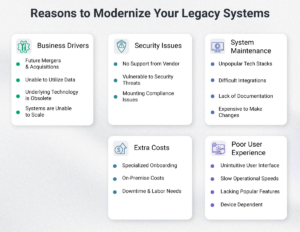
“Traditional exchanges globally are at a critical juncture”, observes Deloitte's “2024 Banking and Capital Markets Outlook” report. “Strategic choices they make now could determine whether they continue to grow—or even retain—market share and garner higher profits.”
Today’s market infrastructure providers need to navigate increased complexity and unpredictability. These pressures in turn intensify the need to urgently modernise outdated infrastructure and tackle technological debt.
2024 is the year, I believe, we will bear witness to the much-anticipated tipping point for transformation of market infrastructure. The question now is: How can you ensure that your technological upgrade will be delivered within a timeframe that secures your competitiveness?
Difficult choices
In the rapidly maturing and advanced landscape of trading technology, staying current is no longer optional. It has become imperative that outdated infrastructure for day-to-day operations is replaced, ensuring the robustness and endurance of the overall technological framework.
Yet strategic choices, particularly concerning market infrastructure technology, are not always straightforward. Legacy providers, in particular, find themselves constrained by outdated technology - from constant project delays and cost concerns, to the difficulty in implementing new features within their existing systems. The limitations of the old legacy systems are becoming increasingly apparent, especially when reaching their end-of-life date (when a vendor no longer markets, sells or releases that particular equipment). As such, many exchanges are actively seeking new solutions to modernise their operations and remain competitive in an ever-evolving technological landscape.
A recent publication by Oliver Wyman advises: “A wave of high-profile, drastic cost-cutting measures have been undertaken by the leading technology outfits and banks – and market infrastructure groups will not be exempt from economising. That’s why it’s important that market infrastructure groups emphasise and deliver on sustainable performance improvements, mindful of their longer-term strategic growth agenda."
Nasdaq CEO Adena Friedman agrees, assuring clients that an infrastructure upgrade can unlock years of growth if done with foresight. Yet she also cautions: “Investing in resilience is hard, it can be expensive and has longer payoff cycles….”
But is this always the case? Does it really need to be this hard, expensive and time-consuming?
A simpler alternative: Cloud-based, capital-grade solutions
If transformation is addressed by cloud-agnostic, digital-centric technology suppliers, then by rights, cloud-based, capital-grade solutions delivered via SaaS (with enormously decreased time-to-market) should become the norm.
Similar to other industries undergoing digital transformation, modern technology solutions are also becoming accessible for regulated exchanges - solutions that can easily handle, for example, more advanced trading strategies and new asset types. In particular, these cloud-agnostic solutions still allow for deployment in on-premises setups with low-latency requirements, and across various environments (excluding production), resulting in substantial cost savings.
Previously, a CIO would be tempted to pay obscene amounts of money for what was considered a ‘safe’, albeit legacy-based, provider. Now forward-thinking decision-makers realise they need to change their approach, and are reviewing all available options in order to ensure competitiveness.
These forward-thinking decision-makers are asking the following question of their technology providers: Is there a multicloud offering? Can the system handle tokenisation and new asset types? What is the timeframe required for the development of a brand new marketplace? And can maximum speeds of latency be maintained for high-frequency trading?
Authentic results
In this year of ‘make or break’ for exchanges, I question the naysayers seemingly set against true innovative change. Those vendors who contend that investing in technology is hard, expensive and long, seem to often veer towards strategies that ultimately delay and postpone change. Who does this really help?
As exchange’s embark on a new year, reflection is needed: Is your technology serving as a facilitator rather than a hindrance? Do your technological capabilities align seamlessly with your objectives? And are they positioned for dependable delivery?
Successful exchanges will be those ready to adopt innovative technologies. An authentic understanding of the complexities involved with modern, digital-first infrastructures is therefore crucial. Furthermore, leveraging SaaS in this instance can mean advancing your team’s velocity, since implementing this change will improve engagement, retention and elevate your team's capabilities for agility, thus ushering in a departure from traditional big bang projects.
After all, it’s not only an exchange’s performance on the line, it may well be its survival.
- SEO Powered Content & PR Distribution. Get Amplified Today.
- PlatoData.Network Vertical Generative Ai. Empower Yourself. Access Here.
- PlatoAiStream. Web3 Intelligence. Knowledge Amplified. Access Here.
- PlatoESG. Carbon, CleanTech, Energy, Environment, Solar, Waste Management. Access Here.
- PlatoHealth. Biotech and Clinical Trials Intelligence. Access Here.
- Source: https://www.finextra.com/blogposting/25588/2024---the-tipping-point-for-market-infrastructure-transformation?utm_medium=rssfinextra&utm_source=finextrablogs
- :has
- :is
- :not
- 2024
- a
- accessible
- across
- actively
- addressed
- adopt
- advanced
- advancing
- against
- agenda
- agrees
- align
- All
- allow
- also
- alternative
- always
- amounts
- an
- and
- apparent
- approach
- ARE
- AS
- asking
- asset
- At
- Authentic
- available
- Banking
- Banks
- BE
- Bear
- become
- becoming
- been
- believe
- Big
- Big Bang
- brand
- by
- CAN
- capabilities
- capital
- Capital Markets
- case
- ceo
- change
- choices
- CIO
- clients
- cloud-agnostic
- competitive
- competitiveness
- complexities
- complexity
- concerning
- Concerns
- considered
- constant
- continue
- Cost
- cost savings
- could
- critical
- crucial
- Current
- Date
- day-to-day
- Debt
- decision-makers
- decreased
- delay
- delays
- deliver
- delivered
- delivery
- deloitte
- departure
- dependable
- deployment
- Determine
- Development
- Difficulty
- digital
- Digital Transformation
- do
- does
- done
- easily
- ELEVATE
- embark
- engagement
- enormously
- ensure
- ensuring
- environments
- equipment
- especially
- Even
- example
- Exchanges
- excluding
- exempt
- existing
- expensive
- facilitator
- Features
- Find
- Finextra
- following
- For
- foresight
- forward-thinking
- Framework
- from
- Furthermore
- garner
- Globally
- Group’s
- Growth
- handle
- Hard
- Have
- help
- High-Frequency
- high-frequency trading
- high-profile
- higher
- hindrance
- How
- HTML
- HTTPS
- i
- if
- imperative
- implementing
- important
- improve
- improvements
- in
- increased
- increasingly
- industries
- Infrastructure
- infrastructures
- innovative
- innovative technologies
- instance
- investing
- involved
- IT
- ITS
- jpg
- landscape
- Latency
- leading
- Legacy
- leveraging
- limitations
- Line
- Long
- longer
- make
- many
- Market
- marketplace
- Markets
- maximum
- May..
- mean
- measures
- Modern
- money
- more
- much-anticipated
- Navigate
- Need
- needed
- New
- New Features
- new solutions
- new year
- no
- now
- objectives
- Observes
- of
- offering
- often
- Old
- oliver
- on
- only
- Operations
- Options
- or
- order
- Other
- outdated technology
- overall
- particular
- particularly
- Pay
- performance
- plato
- Plato Data Intelligence
- PlatoData
- Point
- positioned
- Production
- profits
- project
- projects
- provider
- providers
- Publication
- question
- rapidly
- rather
- reaching
- ready
- really
- recent
- reflection
- regulated
- Releases
- remain
- replaced
- report
- required
- Requirements
- resilience
- resulting
- retention
- reviewing
- rights
- robustness
- s
- SaaS
- Savings
- seamlessly
- Secures
- seeking
- seem
- Sells
- serving
- set
- Share
- she
- should
- simpler
- since
- Solutions
- speeds
- staying
- Still
- straightforward
- Strategic
- strategies
- substantial
- such
- suppliers
- survival
- sustainable
- system
- Systems
- tackle
- team
- technological
- Technologies
- Technology
- than
- that
- The
- their
- themselves
- then
- There.
- therefore
- These
- they
- this
- this year
- those
- Thus
- time-consuming
- timeframe
- Tipping
- Tipping point
- to
- tokenisation
- towards
- Trading
- Trading Strategies
- Trading Technology
- traditional
- Transformation
- true
- TURN
- types
- Ultimately
- undergoing
- understanding
- unlock
- upgrade
- ushering
- various
- VeeR
- VeloCity
- vendor
- vendors
- via
- was
- Wave
- we
- WELL
- What
- What is
- when
- whether
- WHO
- why
- will
- with
- within
- witness
- would
- year
- years
- yet
- you
- Your
- zephyrnet












